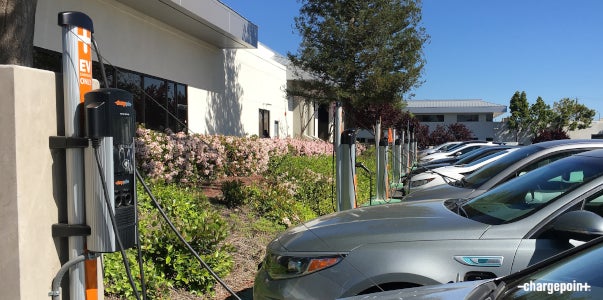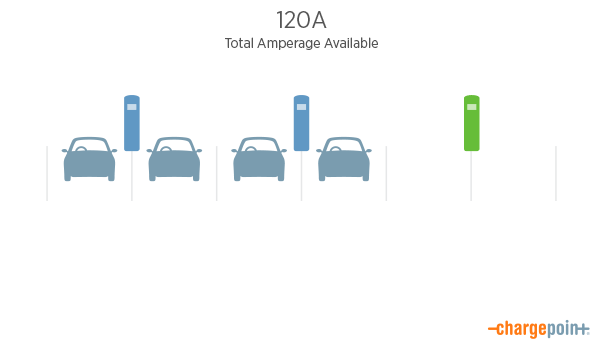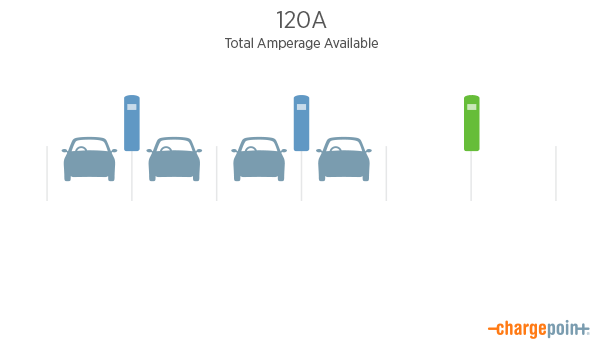
As a facilities manager, you deal with requests for electric vehicle (EV) charging from customers, employees or residents. They may ask you to install EV charging for the first time or add more stations if you already have charging available. Because access to EV charging encourages people to drive electric, installing stations may further increase demand for charging. As U.S. EV sales continue rising (as they have for 21 consecutive months), more EV models come on the market and sustainability programs gain popularity, you’ll probably have even more EV drivers to accommodate soon.
When you handle requests for charging, you’re also dealing with the realities of your electrical infrastructure. You may have constraints on your electrical capacity, or you may be managing an older building that has structural limitations or obstacles to electrical upgrades. Above all, you’re working within a budget that may not allow for an overhaul of your electrical infrastructure. We want to help you do your job, and we understand it’s not always possible to make major electrical updates to install more EV charging. That’s why we’re offering the convenience of Power Management technology: to help customers like you charge more EVs, without costly electrical upgrades.
Power Management Basics
Power Management makes it possible for organizations to meet driver demand and charge more EVs without making major infrastructure updates. Instead of installing additional physical electrical capacity, like new circuits, panels or transformers, Power Management software dynamically shares existing power across more charging spots to charge more vehicles. We can configure Power Management for various industries, delivering greater power at workplaces and less at long-term parking structures. Each vehicle may charge at a slightly slower rate, but a larger number of vehicles get to charge. Power Management is well suited for workplaces, fleet depots, apartments, condos and long-term parking lots where cars are parked for at least a few hours.
Because Power Management never exceeds the rated capacity of a circuit, panel or site, it is completely safe for your building’s electrical infrastructure and for your drivers. The National Electric Code allows for oversubscription of electrical service, and ChargePoint stations are the first EV charging stations to be UL Listed as Energy Management devices. Real-time network communications make sure that our stations operate within the stated electrical load allowance for a site. If an issue occurs, a failsafe mechanism decreases station power usage to a guaranteed safe level and vehicles continue to receive a meaningful, but slower, charge.
Power Management Options
ChargePoint has three different Power Management options, each designed to meet different requirements. The “oversubscription ratio,” or the proportion of charging stations installed compared with the rated capacity, can be varied depending on how long cars are parked and how much charge they typically need. For example, four stations sharing 40 amps of power on a single circuit would have an oversubscription ratio of 4:1.
The right type of Power Management to use varies by location and demand. ChargePoint will guide organizations in configuring Power Management to work best for them.
Equal Charge
Equal Charge shares power equally among vehicles based on their maximum charging rate. It’s designed for drivers at workplaces, apartments and condos who’ll be parked for a reasonable length of time.


First-In, First-Out (FIFO)
FIFO is intended for fleets and supports a higher oversubscription ratio. It ensures that each vehicle gets a full charge as fast as possible based on when it plugged in, so fleets can be sure they’ll always have fully charged vehicles on hand when they need them.


Round Robin
Round Robin works well for fleets and long-term parking lots that have cars with widely varying charging requirements (due to variations in the routes they travel, for example). Each car charges at its maximum rate for a configurable amount of time and power cycles through vehicles based on when they plugged in. Round Robin ensures that vehicles with light charging requirements get a full charge faster.


Again, ChargePoint can help organizations determine which sharing model is the best choice.
Power Management Can Double the Number of Charging Spots Available
Rockwell condominium community in San Francisco used Power Management to double the number of charging stations it offered without making a major electrical infrastructure investment, allowing the community to accommodate more EV drivers. “As a development company, we’re always looking for a competitive advantage. When we started our sales program, people asked if we had EV charging, so we saw the demand,” said Michael McCone, Vice President at Oyster Development Corp.
“ChargePoint worked with Oyster, our electrical contractor and the stacked parking contractor to push for the building department to approve what had never been done before: putting the charging stations on a moving platform,” McCone added, showing how Power Management can complement other construction initiatives, such as stacked parking, for additional financial savings.
EV Drivers Just Need to Plug In
EV drivers appreciate Power Management because it allows them to plug in and go about their day at work, at home or elsewhere with the confidence that their vehicle will get the charge they want and the ability to check charging status in the ChargePoint app. Rather than having to wait for a notification and move their vehicle to an open spot, they’re already plugged in and charging up. Power Management is convenient for drivers, more affordable for station owners and a great way to charge more EVs.
Pick the Power Sharing Options that Work for You
Power sharing allows charging sites to maximize the number of ports they can deploy while still ensuring EV drivers get an adequate charge. It takes advantage of the fact that most cars only need to charge for a few hours but are usually parked for much longer. This allows the electrical capacity of a site to be “oversubscribed” by intelligently managing the available power. Power sharing supports various approaches to delivering additional charging capacity:
-
Circuit sharing allows a circuit to support more than one charging spot.
-
Panel sharing lets a panel support more charging spots than its rated capacity.
-
Site sharing sets a power ceiling to limit the aggregate instantaneous load for all charging stations if the overall power available at a site is limited by a transformer.
Interested in EV charging, but not able to upgrade your electrical infrastructure? Read more, check out the FAQ and contact us to find out more about how Power Management can help you save money while supporting charging.
Not ready for Power Management yet? See how Power Management helped Oyster Development Corp. double the number of stations it was able to install at Rockwell condominium in San Francisco.

